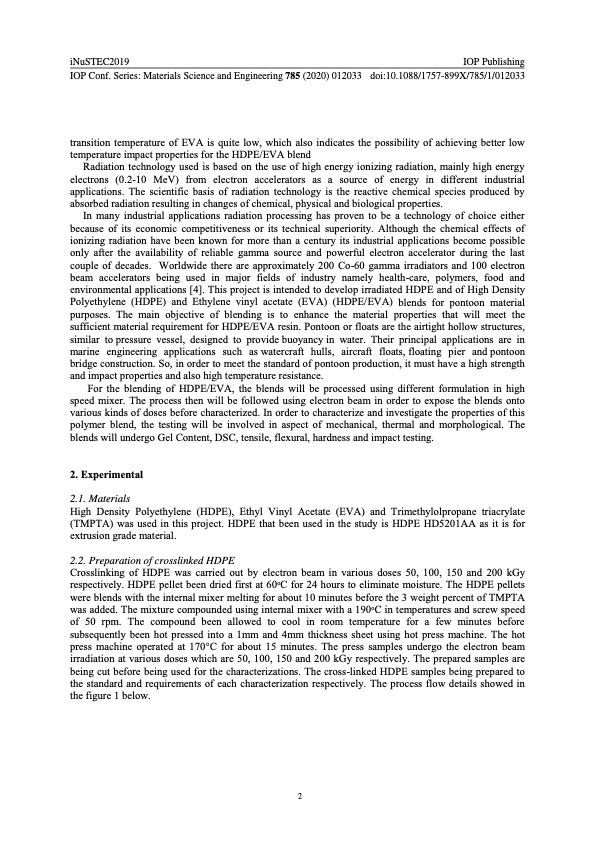
PDF Publication Title:
Text from PDF Page: 003
iNuSTEC2019 IOP Publishing IOP Conf. Series: Materials Science and Engineering 785 (2020) 012033 doi:10.1088/1757-899X/785/1/012033 transition temperature of EVA is quite low, which also indicates the possibility of achieving better low temperature impact properties for the HDPE/EVA blend Radiation technology used is based on the use of high energy ionizing radiation, mainly high energy electrons (0.2-10 MeV) from electron accelerators as a source of energy in different industrial applications. The scientific basis of radiation technology is the reactive chemical species produced by absorbed radiation resulting in changes of chemical, physical and biological properties. In many industrial applications radiation processing has proven to be a technology of choice either because of its economic competitiveness or its technical superiority. Although the chemical effects of ionizing radiation have been known for more than a century its industrial applications become possible only after the availability of reliable gamma source and powerful electron accelerator during the last couple of decades. Worldwide there are approximately 200 Co-60 gamma irradiators and 100 electron beam accelerators being used in major fields of industry namely health-care, polymers, food and environmental applications [4]. This project is intended to develop irradiated HDPE and of High Density Polyethylene (HDPE) and Ethylene vinyl acetate (EVA) (HDPE/EVA) blends for pontoon material purposes. The main objective of blending is to enhance the material properties that will meet the sufficient material requirement for HDPE/EVA resin. Pontoon or floats are the airtight hollow structures, similar to pressure vessel, designed to provide buoyancy in water. Their principal applications are in marine engineering applications such aswatercraft hulls, aircraft floats,floating pier andpontoon bridge construction. So, in order to meet the standard of pontoon production, it must have a high strength and impact properties and also high temperature resistance. For the blending of HDPE/EVA, the blends will be processed using different formulation in high speed mixer. The process then will be followed using electron beam in order to expose the blends onto various kinds of doses before characterized. In order to characterize and investigate the properties of this polymer blend, the testing will be involved in aspect of mechanical, thermal and morphological. The blends will undergo Gel Content, DSC, tensile, flexural, hardness and impact testing. 2. Experimental 2.1. Materials High Density Polyethylene (HDPE), Ethyl Vinyl Acetate (EVA) and Trimethylolpropane triacrylate (TMPTA) was used in this project. HDPE that been used in the study is HDPE HD5201AA as it is for extrusion grade material. 2.2. Preparation of crosslinked HDPE Crosslinking of HDPE was carried out by electron beam in various doses 50, 100, 150 and 200 kGy respectively. HDPE pellet been dried first at 60oC for 24 hours to eliminate moisture. The HDPE pellets were blends with the internal mixer melting for about 10 minutes before the 3 weight percent of TMPTA was added. The mixture compounded using internal mixer with a 190oC in temperatures and screw speed of 50 rpm. The compound been allowed to cool in room temperature for a few minutes before subsequently been hot pressed into a 1mm and 4mm thickness sheet using hot press machine. The hot press machine operated at 170°C for about 15 minutes. The press samples undergo the electron beam irradiation at various doses which are 50, 100, 150 and 200 kGy respectively. The prepared samples are being cut before being used for the characterizations. The cross-linked HDPE samples being prepared to the standard and requirements of each characterization respectively. The process flow details showed in the figure 1 below. 2PDF Image | marine grade radiation cross-linked high density polyethylene (HDPE) floater pontoon

PDF Search Title:
marine grade radiation cross-linked high density polyethylene (HDPE) floater pontoonOriginal File Name Searched:
Development_of_marine_grade_radiation_cross-linked.pdfDIY PDF Search: Google It | Yahoo | Bing
Development of a solar powered Electric Ship The Electricship website originally started off as a project to develop a comprehensive renewable, affordable, modular electric ship... More Info
Modular Boat Hull Composite The case for a unsinkable, modular composite hybrid boat hull... More Info
MS Burgenstock Hybrid Electric Catamaran Lake Lucerne Unique shuttle servicing Lucerne to the Burgenstock Resort... More Info
Ground Power Unit GPU Powered by Lithium Ion Batteries The goal of the Ground Power Unit is to provide a readily accessible, modular, ready-to-power solution for remote power... More Info
| CONTACT TEL: 608-238-6001 Email: greg@electricship.com | RSS | AMP |